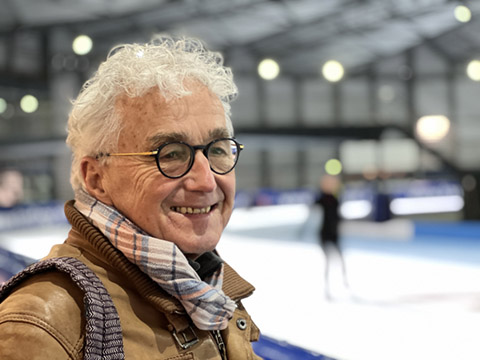
Gerard Sierksma is good as gold
Yay, another skating medal!
The problem is a nice one to have: the Netherlands has many fast speed skaters who could compete at the Olympics, but it can only take so many to the Games. So who do you pick if the goal is to win as many medals as possible?
That’s where Gerard Sierksma comes in. The Dutch dominance in Olympic speed skating owes a debt of gratitude to the retired professor of quantitative logistics, who has helped to streamline the selection of speed skaters for the Dutch Olympic team.
Sierksma, himself a keen speed skater, devised the algorithm known only as ‘The Matrix’. It helps Olympic selectors overcome the headache of deciding which of the many quick Dutch skaters gets to don the orange lycra on the ice.
Starting positions
It’s an issue of quotas and starting positions, Sierksma explains. ‘In Beijing, there are thirty-eight starting positions for skaters, nineteen for men and nineteen for women. The IOC allows the Netherlands to take only nine men and nine women to the games. This means that it has to be worked out who can do the best, not just in one event, but across several distances.’
There used to be a lot of track side politics
The solution? The Matrix. ‘I actually developed the algorithm before anybody asked me to’, Sierksma says. He decided to combine his passions for analytical mathematics and speed skating and approached Arie Koops – the then director of the Dutch speed skating federation KNSB – to see whether they would like to try the algorithm on their selection process.
‘Before The Matrix, there used to be a lot of track side politics’, says former Dutch speed skater and Olympic speed skating coach Gerard Kemkers. ‘Athletes, their coaches and sponsors would all be in the ears of the selection committee – it often led to legal proceedings. It was hardly fair.’
Past performances
Much rides on the accuracy of Sierksma’s algorithm. So how does it work? ‘In essence’, he explains, ‘it takes the past performances of skaters racing in various conditions and predicts how well they will do in the future.’
Nowadays, the calculations of the past performance estimations are done by Sierksma’s former PhD student Bertus Talsma, who is employed by data analyst ORTEC Sports. The two of them recently had a paper published in the journal Operations Research and Management Science, describing the inner workings of the algorithm.
At its core, the algorithm is an integer linear optimization model. Each of the starting positions is ranked based on past results of the Dutch at that distance. Rather than rank skaters, the algorithm ensures that the rankings are arranged by likelihood of a race yielding a medal for the Dutch team. It might be, then, that if Dutch skaters perform poorly that season at a certain distance, that position two and three on the starting line are scratched, and those who skate it are not included in the team.
The ranking is released before the quadrennial Olympic qualification tournament, so that skaters can see where they are expected to finish and perhaps better their chance of being selected.
Hesitant
At first, coaches and athletes were hesitant to select spots based on the algorithm. ‘There was a slow understanding of The Matrix. They weren’t sure,’ Sierksma says. But after successful campaigns in Sochi in 2014 and Pyeongchang four years later off the back of The Matrix, the skating fraternity is ‘completely convinced’.
It’s all going to plan thus far
That’s important, because with the Dutch Olympic mission eying up a spot amongst the top ten nations on the medal table, decisions like these have to have everybody on board. Sierksma likens the algorithm to the engine of a car: ‘The average person knows that their car has an engine and knows how to turn it on, but doesn’t really know how it works. They still trust it though: you have to trust the algorithm just the same.’
Proof
The proof of the pudding, as they say, is in the eating. Sochi saw the Dutch team take home 23 of a possible 36 medals, while in Pyeongchang the team had a haul totaling 16 of 42 possible medals.
And is The Matrix working in Beijing, too? Kemkers may not be part of the Olympic team anymore, but he’s still in the know: ‘It’s all going to plan thus far.’
Some sports purists might worry that Sierksma’s matrix extinguishes some of the romance of sports, but he himself doesn’t. ‘At the end of the day, anything can happen out there on the ice. I just helped to make the process to get there a bit more transparent.’
Kemkers agrees. ‘It’s the skater who decides how fast they skate. They still decide whether they go to the Olympics or not.’